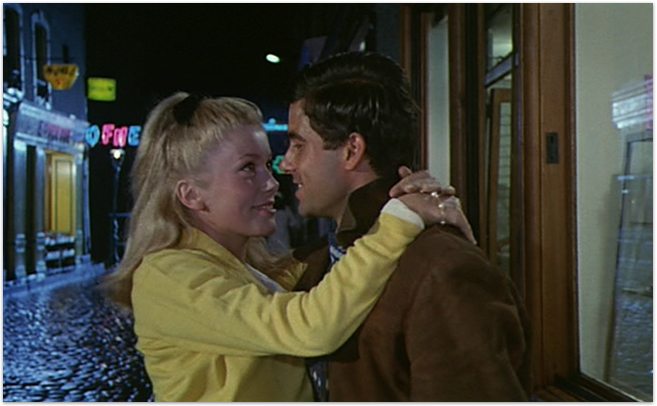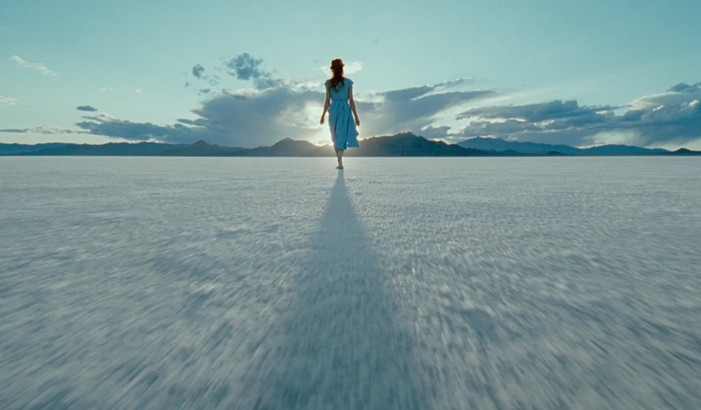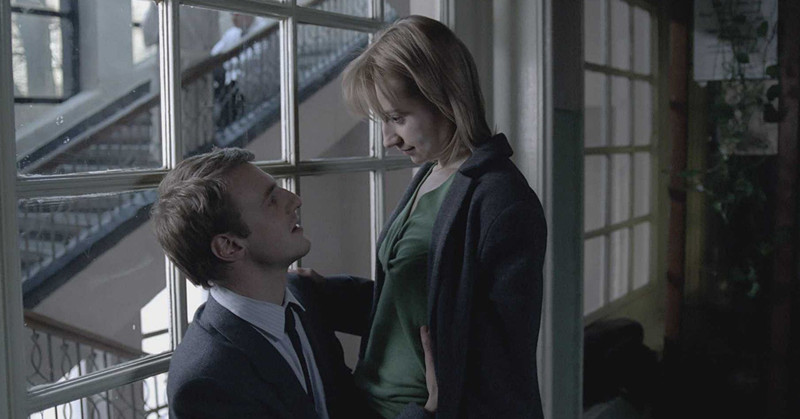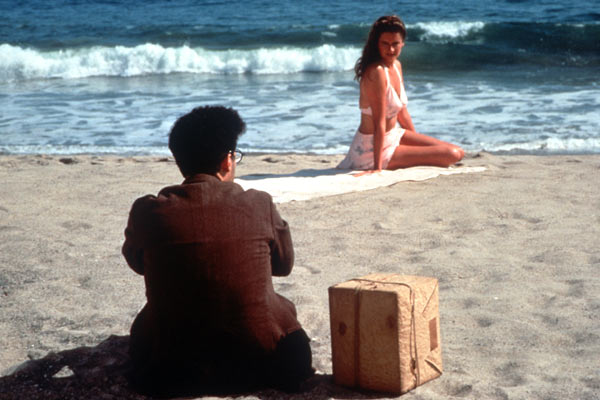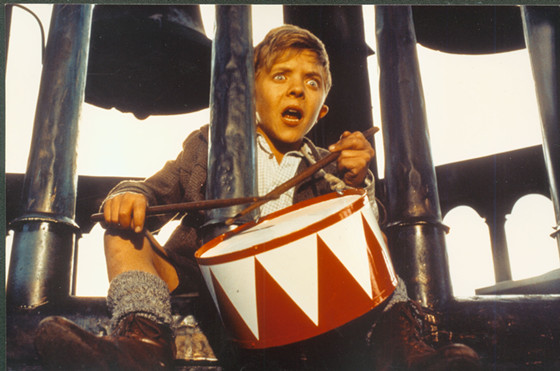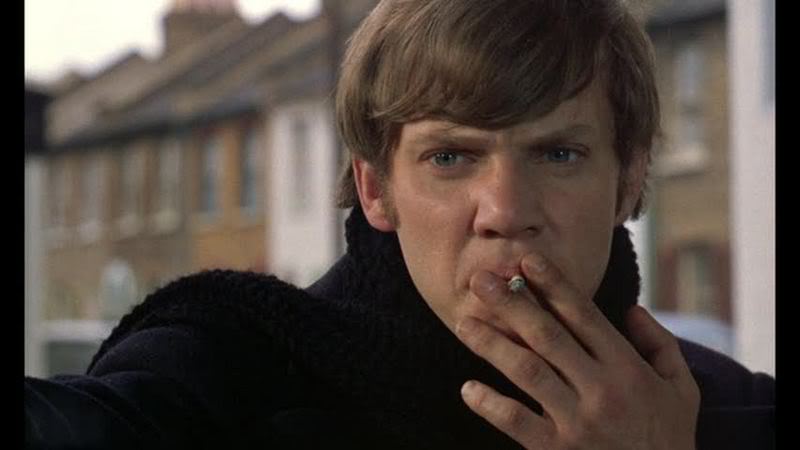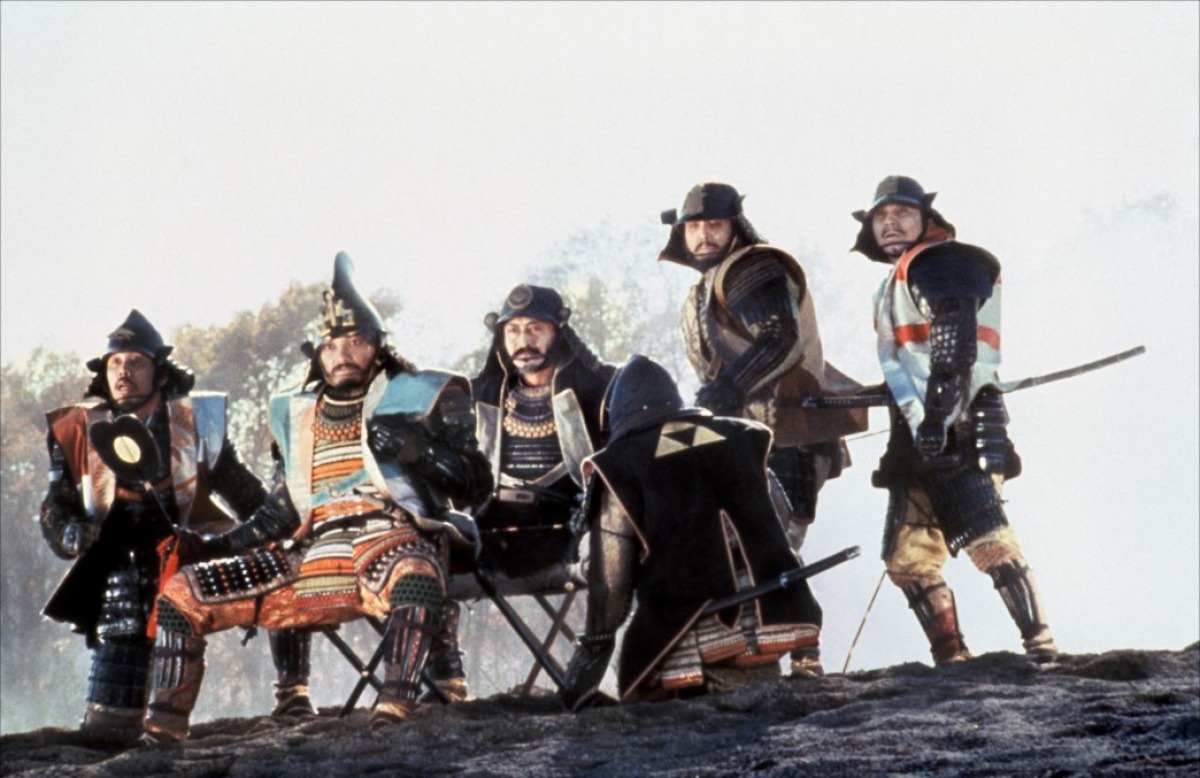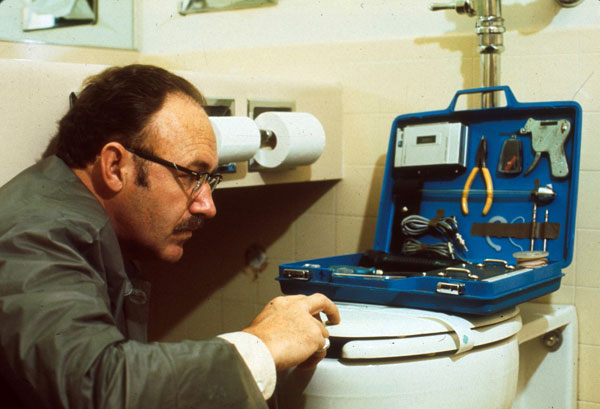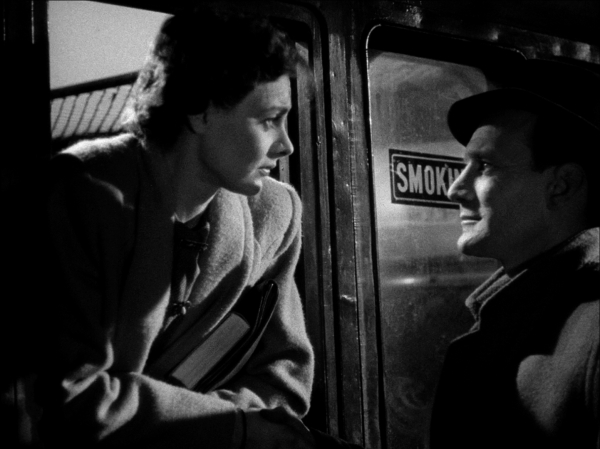17. The Umbrellas of Cherbourg (Jacques Demy, 1964)
A unique musical in its own right, The Umbrellas of Cherbourg employs a rich and vibrant color scheme in its cinematography to bring forth the tale of love that cannot be achieved, even when it wants to be and has the moment to do so.
The story, which is carried and moved entirely by song, starts off with the young Geneviève and her mother who sell umbrellas at their little shop when she meets and falls in love with Guy, a young mechanic who lives with his dear aunt. Within that, Madeleine, who is the caregiver of Guy’s aunt, is in love with the young man as well and her feeling cannot be expressed as he is beholden already and is drafted to fight in the Algerian War.
Years later, after Geneviève and Guy have went their separate ways, she has had his child and married another man and Guy has married Madeleine and is happy with her. It is then that the two childhood lovers happen to meet again at Guy’s gas station when old emotions are brought back to the forefront.
The musical breaches a soaring opera of love and the enticing heights it can reach to, all while becoming a popular hit (especially for the music) in its native France and all over the world, with ever popular Catherine Deneuve leading the singing cast.
16. The Tree of Life (Terrence Malick, 2011)
In Competition in 2011: The Artist, Drive, Melancholia, Once a Upon a Time in Anatolia, The Skin I Live In, We Need to Talk About Kevin and more.
Terrence Malick’s epic poem about we our place is in life, whether it be within the confines of family, of community, of time, of space, of love, of essence, of nature and nurture, of rage and beauty, of being, of what does our place mean in this reality of where we are now.
Following Jack O’Brien wandering as a lost man who works as an architect, he has recently found out about the death of his younger brother, R.L., and reminiscences back to his childhood in Waco, Texas living with his brothers, his ethereal mother and his stern father. Both of their influences, as connected and different as light and night, rage constantly within Jack, just as the elements of the universe from the beginning are always raging since the dawn of time.
The Tree of Life begins with the quote from the Book of Job, asking “Where were you when I laid the foundations of the Earth… when the morning stars sang together?” And that quote lays the actual foundation for the film itself; this is a film, and more directly with Malick himself, asking anyone who would listen on what does it all mean? What does it mean that we are here? It’s not necessarily asking for a direct answer, how do you give a straight answer to a question as huge as the galaxies themselves, but it searching for something or someone to be listening in the first place.
Just like Jack yearns for both of his parents to listen to him, his thoughts, his development as a human being, the allegorical nature of the film takes everything about life that we know it to be – the creation of everything, the formation of Earth, the springing of life – and parallels that celestial scale with the scale of living in an American nuclear family. Both have their beginnings, both have their scope and both are created of several aspects that need each other to survive, strive and eventually, move on.
Jury president Robert De Niro was quoted as saying that The Tree of Life “fit the bill… it had the size, importance, intention, whatever you want to call it, that seemed to fit the prize,” and Malick reached for those heights in his most ambitious attempt and scope seen to date.
Led by Brad Pitt, Jessica Chastain and Sean Penn giving impeccable performances that fit and portrayed the spiritual nature of Malick story, accompanied by some of the best work that Emmanuel Lubezki has ever lensed, The Tree of Life is the film that Malick has been pursuing his whole career.
15. 4 Months, 3 Weeks and 2 Days (Cristian Mungiu, 2007)
In Competition in 2007: The Diving Bell and the Butterfly, The Mourning Forest, No Country For Old Men, Persepolis, Secret Sunshine, Zodiac and more
At the time, we saw the budding emerge of a Golden Age of Romanian cinema, with the likes of The Death of Mr. Lăzărescu by Cristi Puiu, 12:08 East of Bucharest by Corneliu Porumboiu, The Way I Spent the End of the World by Cătălin Mitulescu and others, but Mungiu’s in the trials of living in Communist Romania from an everyday, and even momentous standpoint, spoke volumes.
Inspired by real stories from acquaintances and friends, Mungui’s film details the life of two university students, Otilia and Gabriela, who are entrenched in the trivialities of life, involving boyfriends, studying for exams, their futures and procuring an abortion.
Regulated in rather glib detail in being described as ‘the Romanian abortion movie,’ 4 Months is functionally looks at how difficult life is under the totalitarian rule of Nicolae Ceaușescu – within the framework of the film, the abortion is essentially a MacGuffin of the plot (as harsh as that is to say).
The meat of the plot really portrays the claustrophobia of everyday items and effects that one would usually wouldn’t think twice of; hair dryers, cigarettes, movies, hotels. Everything comes with a price and as we see through the film, everyone does as well.
The film is held together by the three main performances in Anamarica Marinca as Otilia who even though she is not the main character (nor is she the one actually getting the abortion), she is the one who is in every frame of the film and who the audience is tethered to throughout. Marinca’s Otilia is a striking portrayal of all the tools an actor has an their disposal; the occupation of space, letting the face create and move the story of the character and a forceful presence that makes the best of all the situations that are given to her.
Where Marinca is steeled, Laura Vasiliu’s Gabriela is the opposite; scared, unsure and it carries the necessary dynamic between the two fully-developed women and fleshes out their friendship. The man in this triumvirate is Vlad Ivanov’s Mr. Bebe, the back alley abortionist who walks the girls through this endeavor and manipulates them for his own advantage.
Even though his actions are despicable, the film treats the actions of Bebe (and the girls themselves) as products of their environment – with abortion being a high-level criminal offense in Romania, why should he stick his neck out with no benefit for his own?
The film offers no easy answers in this world, not for the characters and for the audience as well. Deploying long takes, static shots where the characters move in and out of frame and carry the action, Mungiu limits the audience in the same predicament that the people living in this exact time period felt themselves.
The last shot of the film is Otilia and Gabriela sitting in a restaurant, ordering food and saying that they will never speak about this moment again. Life goes on, but unfortunately this moment in Romanian history was spoken about again and struck such a chord with Stephen Frears’ led jury that is prevailed at Cannes and prevailed across the world in its influence.
14. Barton Fink (Joel and Ethan Coen, 1991)
In Competition in 1991: A Rage in Harlem, The Double Life of Veronique, Europa, Homicide, Jungle Fever, Van Gogh and more.
In another example of being ahead of the curve in finding emerging talent (American talent especially as we see), Roman Polanski’s jury tapped the Coen Brothers in their fourth film for the top prize in a film that defies all genre classification. In true form, it is best defined as a Coen Brothers movie.
Playwright Barton Fink (John Turturro) has great success with his Broadway play when Hollywood comes knocking with a great offer for the reluctant writer; Capitol Pictures tycoon Jack Lipnick assigns Fink to write a wrestling picture and holed up in his room at the Hotel Earle, Fink suffers from writer’s block, distractions from the noises from his neighbor next door in Charlie Meadows and a very persistent mosquito. After trying to get assistance from a novelist and his security, Fink’s writer’s block and him staying at the hotel begin to spiral incredibly out of control as 1941 looms ahead in the form of war.
Perhaps it was because Joel and Ethan Coen noted that they were influenced by his own films (especially in Repulsion and The Tenant) that Polanski felt a connection to the film, but the film also made a connection to various topics (Hollywood versus Broadway, the common man, that common man entangled in situations beyond them) that the Coens have, and would, visit again and again.
13. The Tin Drum (Volker Schlöndorff, 1979)
The co-winner of the 1979 festival with Coppola’s Apocalypse Now, The Tin Drum is an overarching tale of time depicting the family and life of young Oskar Matzerath, who by his own volition, decides to stop physically growing by the age of three.
Starting at the turn of the century from 1899, the tale begins with Oskar’s grandfather running from the police by hiding under the skirt of a woman who he eventually marries and starts a family with. His daughter, Agnes, involves herself in a love affair with her cousin Jan Bronski and his friendly rival Alfred Matzerath and Oskar is soon born.
After an accident of falling down the stairs, Oskar stops growing and develops an ability to shatter glass with his voice, which he uses to great effect from time to time, and his favorite toy; a tin drum for a caring local toymaker. With the rise of Nazism slowly coming in, Oskar meets a traveling troupe and travels all over Europe as the war affects everything and everyone around them.
The story, described as a surrealist black comedy, touches on how the strains of war can affect family life but also through controversial means involving adultery, obscenity and death. Both The Tin Drum and Apocalypse Now have the framework of slow and absolute reaches of war and how surreal and dark those reaches can be.
12. If… (Lindsay Anderson, 1968)
Released in 1968, Anderson’s energetically turbulent film spoke to a number of cases that were happening around the world at the time; from the May students riots in France, to the riots in the United States and the assassinations of both Martin Luther King, Jr. and Robert Kennedy to the counterculture at its apex in general. If… was just the film to come right around the perfect moment in time.
Looking at the posh British school system with a very sarcastic and dark eye, students Mick Travis (Malcolm McDowell, warming up for A Clockwork Orange) and his pals Wallace and Johnny rebel against the older students that supervise, and lord, over them and against the Headmasters and the overall establishment. Going through the school’s ceremonies, customs and traditions, Mick encounters The Girl and later on, having enough of authorities and their battles against them, spur on a brutal shooting spree on the rooftops to everyone in the school.
While drinking, the boys recite a quote of “one man can change the world with a bullet in the right place,” and while they go on to exact that quote in literal bloodshed, the film all considers it of the world itself. As the last shot indicates with the close-up of Mick’s face while he continues to fire away at everyone in front of him, the title asks the audience a simple ‘if…’
11. Kagemusha (Akira Kurosawa, 1980)
Kurosawa’s epic that discussed the notions of identity, political subterfuge and the sprawling of Japanese history. Being one of Kurosawa’s most successful films in his career, it is also one of his most beautiful, earning top marks in its art design, cinematography and costume design.
The translation of ‘kagemusha’ is shadow warrior, aspiring to a political decoy and that is what is shown with the main character; a thief with an uncanny physical resemblance to a warlord that is in the midst of battle. After conquering a castle, the warlord is killed and to hide the fact from their enemies who would take advantage accordingly, bring in the thief to pose as the warlord full time.
At first, the thief is unaware that the warlord is even dead but after discovering the news on his own, throws himself into the role; so much so, that he learns all he can about the man and fools everyone around him into thinking he actually is him. Until a critical moment at the Battle of Nagashino that results in the army’s defeat and death.
In true Kurosawa fashion, this epic was indeed an epic, with fans Francis Ford Coppola and George Lucas being named as executive producers and helping with the production costs of the film along with Kurosawa using over five thousands extras for the final battle showdown. Kurosawa would later incorporate these into his next and last epic, Ran.
10. The Conversation (Francis Ford Coppola, 1974)
In between crafting The Godfather franchise in 1972 and 1974, Francis Ford Coppola was able to find time to make a small picture about surveillance that would go on to be held up as a worthy equal to his epic mafia pictures.
Harry Caul is the best at what he does, and what he does is surveillance. He can record a conversation between people anywhere, but he racked with guilt over a previous job he did that lead to the death of three people and he himself is overly cautious in his own life.
Hired on a job by The Director, Caul and his crew follow a couple in San Francisco and hears the cryptic phrase “He’ll kill us if he got the chance.” Becoming more and more entrenched in the well-being of the couple, Caul tries to protect the couple while trying to figure out what the message could actually mean in regards to his own safety.
Inspired by Michelangelo Antonioni’s Blowup, the film came before that of the Watergate scandal and surprisingly enough, depicted a lot of the same technology and approaches that the illegal wiretap operation employed. In those regards, the film is an exacting showing of its time but is still able to effortlessly carry over to the present led by a career-capping performance by Gene Hackman.
9. Brief Encounter (David Lean, 1945)
Another co-winner of 1946, and before David Lean went the more epic route, this drama looks simple on its surface but that has always been the deceptive and captivating appeal of Lean’s work.
This film is anything but simple; co-written by acclaimed playwright Noël Coward, the story focuses on Laura Jesson and her marriage to husband Fred which appears to be a comfortable but dull marriage. It’s until she is on her weekly errands of shopping and going to the movies that she runs into a cataclysm that up ends her entire world – the affection of gentle doctor Alec Harvey.
Laura and Alec begin a rather benign friendship enjoying each other’s company, until the complications of lying to friends about their meetings comes up and even more so, the realization of something deeper happening between them. The chemistry and acting prowess between Celia Johnson and Trevor Howard is a dream to witness, especially as the friendship evolves into a relationship and full blown into an affair with real consequences and real stakes with each of them having a family with children.
The pressure is turned up as the couple is caught by Alec’s friend as they use his flat, Laura is encountered by a copper with the implication that she could be a streetwalker and Alec is given an opportunity to be done with everything with a job to South Africa.
The film takes a nuanced approach in the couple’s final departure; instead of a drawn out and emotional goodbye, Laura and Alec barely get time by themselves and the anguish of that missed opportunity is felt instead. The final scene puts a timeless stamp on the film, in where Laura comes back home to Fred who simply thanks her for coming back home to him.
